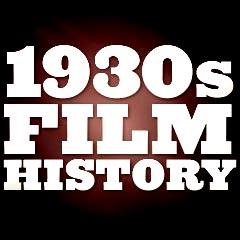|
The Domination of the Studio System:
 The American film industry was dominated by five major corporate-style
studios in the 1930s (and into the 40s). Some of them had originally rebelled
against the MPPA (Motion Picture Patents Company) - see their development
in the previous sections. The Hollywood studios with their escapist "dream
factories" and their "Front Office" studio head, production
chief, producers, and other assistants, were totally in control and at
full strength. They exerted their influence over choice of films, budgets,
the selection of personnel and scripts, actors, writers, and directors,
editing, scoring, and publicity:
The American film industry was dominated by five major corporate-style
studios in the 1930s (and into the 40s). Some of them had originally rebelled
against the MPPA (Motion Picture Patents Company) - see their development
in the previous sections. The Hollywood studios with their escapist "dream
factories" and their "Front Office" studio head, production
chief, producers, and other assistants, were totally in control and at
full strength. They exerted their influence over choice of films, budgets,
the selection of personnel and scripts, actors, writers, and directors,
editing, scoring, and publicity:
- 20th Century Fox (formed in 1935 from the
merger of Twentieth Century Pictures, founded by Joseph Schenk, and
the Fox Film Corporation)
- MGM (Metro-Goldwyn-Mayer) (led by Louis B. Mayer)
- Paramount
- Warner Bros.
- RKO Radio
Three other minor studios were close behind:
- Columbia (headed by Harry Cohn from 1932)
- Universal
- United Artists
Republic Pictures (founded in 1935) and Monogram were relegated to B-picture
status, and Disney was a specialized studio for animation. [The stylized
logos of some of the studios have remained similar over many decades:
Warners (shield), Universal (globe), and Fox (searchlights).]
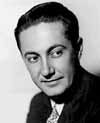 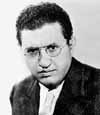 Most
of the late 20's and 30's studio chiefs relied on their production
heads for story decisions: 'Boy Wonder' Irving Thalberg (first at
Universal, then MGM), David O. Selznick (RKO, MGM), and Darryl Zanuck
(Fox). Until his death in 1936, gentleman production executive/tycoon
Irving Thalberg was responsible for high-powered, prestigious, Best
Picture-winning films that served as star vehicles, e.g., Grand Hotel
(1932), Mutiny on the Bounty (1935),
and The Great Ziegfeld (1936). However, iron-fisted, stubborn Thalberg
was known for clashes with extravagant silent film actor-director Erich
von Stroheim over his films, such as Foolish Wives (1922) and Merry-Go-Round
(1923). Most
of the late 20's and 30's studio chiefs relied on their production
heads for story decisions: 'Boy Wonder' Irving Thalberg (first at
Universal, then MGM), David O. Selznick (RKO, MGM), and Darryl Zanuck
(Fox). Until his death in 1936, gentleman production executive/tycoon
Irving Thalberg was responsible for high-powered, prestigious, Best
Picture-winning films that served as star vehicles, e.g., Grand Hotel
(1932), Mutiny on the Bounty (1935),
and The Great Ziegfeld (1936). However, iron-fisted, stubborn Thalberg
was known for clashes with extravagant silent film actor-director Erich
von Stroheim over his films, such as Foolish Wives (1922) and Merry-Go-Round
(1923).
 The
beginning of the decline of the major studio system in the late 30s was
signaled by various aggressive producers who split off and became independent.
For example, David Selznick resigned from MGM in 1935 and established
his own independent company - Selznick International Pictures.
As an independent producer, David O. Selznick served as a "one-man" film
industry with tremendous authority and power over the selection of stars
and decisions of directors. Their first film production, an adaptation of Little Lord Fauntleroy (1936), starred Freddie Bartholomew. The
beginning of the decline of the major studio system in the late 30s was
signaled by various aggressive producers who split off and became independent.
For example, David Selznick resigned from MGM in 1935 and established
his own independent company - Selznick International Pictures.
As an independent producer, David O. Selznick served as a "one-man" film
industry with tremendous authority and power over the selection of stars
and decisions of directors. Their first film production, an adaptation of Little Lord Fauntleroy (1936), starred Freddie Bartholomew.
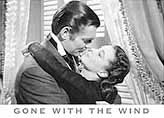 The
top-grossing Gone With the Wind (1939)
was the most expensive film of the decade at $4.25 million. It was also
Selznick's biggest triumph (and after the film's success he spent the
rest of his life attempting to repeat the feat), winning a record eight
Academy Awards. He purchased film rights to the best-selling novel from
first-time author Margaret Mitchell for $50,000 (an astronomical, unprecedented
cost at the time), cast the stars for the film (gambling on Vivien Leigh
as the fiery Scarlett O'Hara), conflicted with and bullied director George
Cukor and finally dismissed him, and insisted on using the audacious words
of Rhett Butler's farewell ("Frankly, my dear, I don't give a damn") in
defiance of the Hays Office - he was allegedly fined $5,000 for using
the word "damn." Although he had originally intended to make the film
his own independent production, the fact that highly-paid contract super-star
Clark Gable was borrowed from MGM and the subsequent high price of the
film forced Selznick to agree to let MGM release the film (and receive
half the profits). The film was memorable in that Hattie McDaniel became
the first African-American to win an Academy Award (as Best Supporting
Actress). The
top-grossing Gone With the Wind (1939)
was the most expensive film of the decade at $4.25 million. It was also
Selznick's biggest triumph (and after the film's success he spent the
rest of his life attempting to repeat the feat), winning a record eight
Academy Awards. He purchased film rights to the best-selling novel from
first-time author Margaret Mitchell for $50,000 (an astronomical, unprecedented
cost at the time), cast the stars for the film (gambling on Vivien Leigh
as the fiery Scarlett O'Hara), conflicted with and bullied director George
Cukor and finally dismissed him, and insisted on using the audacious words
of Rhett Butler's farewell ("Frankly, my dear, I don't give a damn") in
defiance of the Hays Office - he was allegedly fined $5,000 for using
the word "damn." Although he had originally intended to make the film
his own independent production, the fact that highly-paid contract super-star
Clark Gable was borrowed from MGM and the subsequent high price of the
film forced Selznick to agree to let MGM release the film (and receive
half the profits). The film was memorable in that Hattie McDaniel became
the first African-American to win an Academy Award (as Best Supporting
Actress).
MGM's Studio Dominance in the 30s:
 The
'star system' flourished with each studio having its own valuable 'properties',
and Irving Thalberg was responsible for promoting MGM's stars like no
other. The 30s was the age of lavish glamour and sex appeal, and MGM became
the biggest, most predominant and most star-studded studio of all, making
it "The Home of the Stars." It promised "more stars than there
are in heaven," and brought Jeanette MacDonald-Nelson Eddy films
to the screen. And the studio also had high quality productions due to
its great craftsmen, including King Vidor, Victor Fleming, and George
Cukor. The
'star system' flourished with each studio having its own valuable 'properties',
and Irving Thalberg was responsible for promoting MGM's stars like no
other. The 30s was the age of lavish glamour and sex appeal, and MGM became
the biggest, most predominant and most star-studded studio of all, making
it "The Home of the Stars." It promised "more stars than there
are in heaven," and brought Jeanette MacDonald-Nelson Eddy films
to the screen. And the studio also had high quality productions due to
its great craftsmen, including King Vidor, Victor Fleming, and George
Cukor.
By 1934, MGM had over 60 big-name actors under contract. MGM had the
largest 'stable' of stars of all the studios, including: Joan Crawford
(originally a shopgirl named Lucille Le Sueur), Clark Gable, Myrna Loy,
William Powell, Greta Garbo, Norma Shearer, Jean Harlow, Robert Montgomery,
Judy Garland, Mickey Rooney, Katharine Hepburn, Spencer Tracy, James Stewart,
the Barrymores, and Spencer Tracy.
One of its greatest early hits was the star-driven,
profitable Best Film-winning
Grand Hotel (1932), set in an opulent
hotel in Berlin with extravagant art direction by Cedric Gibbons.
The characters in the popular melodrama included the following highly-paid
contract actors: Swedish star Greta Garbo as a ballet dancer, John
Barrymore as a jewel thief, Joan Crawford as a young stenographer,
Wallace Beery as a tyrannical, braggart businessman, and Lionel Barrymore
as a terminally-ill bookkeeper. It also thrived with its Tarzan series
of adventure/jungle films, Tom
and Jerry cartoons, Gone With the
Wind (1939), and The Wizard of Oz
(1939).
Other Major Studios:
20th Century Fox was known for its musicals (especially
in the 40s with Betty Grable), and prestige biographies (such as Young
Mr. Lincoln (1939)). Fox Studios also capitalized on its association
with Shirley Temple after the mid-30s - singlehandedly, she made over
$20 million for Fox in the late 30s.
 RKO
was the locale for the first films of Orson Welles (Citizen
Kane (1941) and The Magnificent Ambersons
(1942)), the sophisticated dance films of Fred Astaire and Ginger
Rogers, comedies, and its seminal monster film King
Kong (1933). RKO
was the locale for the first films of Orson Welles (Citizen
Kane (1941) and The Magnificent Ambersons
(1942)), the sophisticated dance films of Fred Astaire and Ginger
Rogers, comedies, and its seminal monster film King
Kong (1933).
Universal prospered with noted director Tod Browning,
westerns, W.C. Fields and Abbott and Costello comedies, the Flash Gordon
serials, and its archetypal, low
budget horror films such as Dracula (1931),
Frankenstein (1931) and The Wolf Man
(1941).
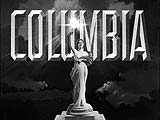 Columbia's
best director was Frank Capra, known for his folksy, fairy-tale "Capra-corn"
pictures. He directed many of this era's best populist and homespun tales
with grass-roots heroes, that did surprisingly well once they were screen
in small-town theatres. His romantic comedies made at the height of the
Depression included the unprecedented hit It Happened
One Night (1934) about a struggling hack reporter and a rich heroine
thrown together, and Mr. Deeds Goes to Town (1936),
about a millionaire who attempted to give away his newly-acquired inheritance. Columbia's
best director was Frank Capra, known for his folksy, fairy-tale "Capra-corn"
pictures. He directed many of this era's best populist and homespun tales
with grass-roots heroes, that did surprisingly well once they were screen
in small-town theatres. His romantic comedies made at the height of the
Depression included the unprecedented hit It Happened
One Night (1934) about a struggling hack reporter and a rich heroine
thrown together, and Mr. Deeds Goes to Town (1936),
about a millionaire who attempted to give away his newly-acquired inheritance.
 Paramount
Studios on the other hand, with a more European, continental sophistication
and flavor, boasted husky-throated Marlene Dietrich and director Josef
von Sternberg, Gary Cooper, Cary Grant, Carole Lombard, Fredric March,
Claudette Colbert, and director Ernst Lubitsch with his 'sophisticated'
comedies: Trouble in Paradise (1932), Angel
(1937), and Ninotchka (1939). They
also featured comedies from Mae West, W.C. Fields, the Marx Brothers,
Bob Hope, and Bing Crosby, musicals starring Maurice Chevalier, and films
from Cecil B. DeMille. Paramount
Studios on the other hand, with a more European, continental sophistication
and flavor, boasted husky-throated Marlene Dietrich and director Josef
von Sternberg, Gary Cooper, Cary Grant, Carole Lombard, Fredric March,
Claudette Colbert, and director Ernst Lubitsch with his 'sophisticated'
comedies: Trouble in Paradise (1932), Angel
(1937), and Ninotchka (1939). They
also featured comedies from Mae West, W.C. Fields, the Marx Brothers,
Bob Hope, and Bing Crosby, musicals starring Maurice Chevalier, and films
from Cecil B. DeMille.
Warner Bros. was male-dominated and fast-moving, and noted for gritty,
cutting-edge, realistic films or biopics, war films, Westerns, and socially-conscious,
documentary-style films. The studio also churned out Golddiggers
musicals almost every year (beginning in 1929) in the decade, and in the
40s - Bugs Bunny and other cartoons. In the early 30s, Warners
also inaugurated the crime-gangster film, with its Little
Caesar (1930), The Public Enemy (1931),
Scarface (1932), and The
Roaring Twenties (1939). The studio thrived with director Michael
Curtiz, and famous "tough guy" stars including: James Cagney,
Paul Muni, Humphrey Bogart, and Edward G. Robinson. Its female stars were
equally forbidding, and included Bette Davis, Barbara Stanwyck, Lauren
Bacall, and Ida Lupino.
The Biggest 30s Stars:
Films were made with specific stars in mind who often played familiar
character types, including the decade's biggest stars: Clark Gable, Paul
Muni, Janet Gaynor, Eddie Cantor, Wallace Beery, Mae West, Greta Garbo,
Jean Harlow, Astaire and Rogers, Claudette Colbert, Dick Powell, W. C.
Fields, Joan Crawford, Marie Dressler, James Cagney, Bing Crosby, Jeanette
MacDonald, Barbara Stanwyck, Johnny Weismuller, Gary Cooper, Norma Shearer,
Robert Taylor, Myrna Loy, Tyrone Power, Alice Faye, Errol Flynn, Bette
Davis, Spencer Tracy, James Stewart, Veronica Lake, and Katharine Hepburn.
Many audiences enjoyed the juvenile company of Shirley Temple, Deanna
Durbin, Judy Garland, and Mickey Rooney. There were also a number of British
stars in the decade, including Ronald Colman, Basil Rathbone (the Sherlock
Holmes of the screen), Charles Laughton (an Oscar-winner in 1933 as King
Henry VIII), C. Aubrey-Smith, and Leslie Howard.
The Greatest Directors of the Era:
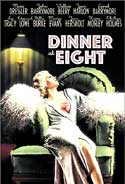 Despite
censorship and strict studio control, many of cinema's best films were
produced in this decade. Under the studio system, certain directors achieved
a distinctive style or genre pattern. MGM's directors (George Cukor, King
Vidor, Jack Conway, Sidney Franklin, Fritz Lang, Clarence Brown, Sam Wood,
and Victor Fleming) were the best filmmakers in the 1930s. Craftsman-director
George Cukor directed Dinner at Eight (1933)
with a galaxy of MGM stars including Marie Dressler, John Barrymore, Wallace
Beery, Jean Harlow, Lionel Barrymore and more. Also he directed W. C.
Fields in David Copperfield (1935), Romeo and Juliet (1936)
with an older Norma Shearer (Irving Thalberg's own wife) and Lesley Howard,
and screen goddess Greta Garbo in one of her last great roles in the exquisite
romance Camille (1936) - a magically-romantic
melodrama opposite up-coming MGM star Robert Taylor. Cukor also directed
Katharine Hepburn in three classics: Little Women (1934), Holiday
(1938) and The Philadelphia Story (1940). Despite
censorship and strict studio control, many of cinema's best films were
produced in this decade. Under the studio system, certain directors achieved
a distinctive style or genre pattern. MGM's directors (George Cukor, King
Vidor, Jack Conway, Sidney Franklin, Fritz Lang, Clarence Brown, Sam Wood,
and Victor Fleming) were the best filmmakers in the 1930s. Craftsman-director
George Cukor directed Dinner at Eight (1933)
with a galaxy of MGM stars including Marie Dressler, John Barrymore, Wallace
Beery, Jean Harlow, Lionel Barrymore and more. Also he directed W. C.
Fields in David Copperfield (1935), Romeo and Juliet (1936)
with an older Norma Shearer (Irving Thalberg's own wife) and Lesley Howard,
and screen goddess Greta Garbo in one of her last great roles in the exquisite
romance Camille (1936) - a magically-romantic
melodrama opposite up-coming MGM star Robert Taylor. Cukor also directed
Katharine Hepburn in three classics: Little Women (1934), Holiday
(1938) and The Philadelphia Story (1940).
 Jack
Conway directed Viva Villa! (1934) (co-directed with Howard Hawks),
Tarzan and His Mate (1934), A Tale
of Two Cities (1935), Libeled Lady (1936), Saratoga (1937)
(Harlow's last film), and Too Hot to Handle (1938). Before coming
to Hollywood, German director Fritz Lang's first 'talkie' was the chilling
M (1931), with Peter Lorre's film debut as a deviant serial killer
(child murderer) who whistled Grieg's Peer Gynt while stalking
his next victim. Sam Wood's best 30s films were Goodbye,
Mr. Chips (1939) and two Marx Brothers films, A
Night at the Opera (1935) and A Day at
the Races (1937). King Vidor directed The Champ (1932)
and Stella Dallas (1937) - among others. Jack
Conway directed Viva Villa! (1934) (co-directed with Howard Hawks),
Tarzan and His Mate (1934), A Tale
of Two Cities (1935), Libeled Lady (1936), Saratoga (1937)
(Harlow's last film), and Too Hot to Handle (1938). Before coming
to Hollywood, German director Fritz Lang's first 'talkie' was the chilling
M (1931), with Peter Lorre's film debut as a deviant serial killer
(child murderer) who whistled Grieg's Peer Gynt while stalking
his next victim. Sam Wood's best 30s films were Goodbye,
Mr. Chips (1939) and two Marx Brothers films, A
Night at the Opera (1935) and A Day at
the Races (1937). King Vidor directed The Champ (1932)
and Stella Dallas (1937) - among others.
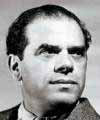 Frank
Capra, for Columbia, collaborated with Robert Riskin, who won the Best
Adapted Screenplay Oscar for his marvelous script and its characters (played
by Clark Gable and Claudette Colbert) in the romantic comedy and on-the-road
adventure It Happened One Night (1934).
This was the first film to win all the top Oscars (Best Picture,
Best Actor, Best Actress, and Best Director), and one of the first screwball
comedies. Riskin went on to write other nominated screenplays for Capra's
Mr. Deeds Goes to Town (1936) (with Gary
Cooper), Lost Horizon (1937) - a classic
tale of a long-lost Shangri-La stumbled upon by a group of disparate travelers,
and for Oscar-winning Best Picture You Can't Take It With You (1938)
- a loveable film adaptation from the stage classic. Capra also directed
James Stewart in Mr. Smith Goes to Washington (1939),
an inspiring film about a crusading Senator that garnered eleven Oscar
nominations (and one win for Lewis R. Foster's Best Original Story). Frank
Capra, for Columbia, collaborated with Robert Riskin, who won the Best
Adapted Screenplay Oscar for his marvelous script and its characters (played
by Clark Gable and Claudette Colbert) in the romantic comedy and on-the-road
adventure It Happened One Night (1934).
This was the first film to win all the top Oscars (Best Picture,
Best Actor, Best Actress, and Best Director), and one of the first screwball
comedies. Riskin went on to write other nominated screenplays for Capra's
Mr. Deeds Goes to Town (1936) (with Gary
Cooper), Lost Horizon (1937) - a classic
tale of a long-lost Shangri-La stumbled upon by a group of disparate travelers,
and for Oscar-winning Best Picture You Can't Take It With You (1938)
- a loveable film adaptation from the stage classic. Capra also directed
James Stewart in Mr. Smith Goes to Washington (1939),
an inspiring film about a crusading Senator that garnered eleven Oscar
nominations (and one win for Lewis R. Foster's Best Original Story).
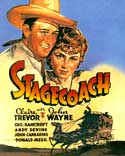 Fox's
long-reigning production chief from the 30s onward was Darryl F. Zanuck
and its finest film director was John Ford, whose films in the 30s included
The Lost Patrol (1934), Drums Along the Mohawk (1939), the
travelers-in-peril tale Stagecoach (1939)
(marked by Ford's first filming in his favorite Monument Valley, and John
Wayne's break-out role as the Ringo Kid), and Young Mr. Lincoln (1939).
The success of Max Steiner's composed musical score for Ford's The
Informer (1935) encouraged the future development of musical soundtracks
and accompaniment. Fox's
long-reigning production chief from the 30s onward was Darryl F. Zanuck
and its finest film director was John Ford, whose films in the 30s included
The Lost Patrol (1934), Drums Along the Mohawk (1939), the
travelers-in-peril tale Stagecoach (1939)
(marked by Ford's first filming in his favorite Monument Valley, and John
Wayne's break-out role as the Ringo Kid), and Young Mr. Lincoln (1939).
The success of Max Steiner's composed musical score for Ford's The
Informer (1935) encouraged the future development of musical soundtracks
and accompaniment.
Producer Samuel Goldwyn's most fruitful collaboration was with director
William Wyler. Examples of their "quality cinema" and stylish melodramas
include: Dodsworth (1936), These Three (1936), Dead End
(1937) (that introduced the Dead End Kids), and Wuthering
Heights (1939) (and The Little Foxes (1941) and The
Best Years of Our Lives (1946) in the next decade).
 Film History of the 1930s
Film History of the 1930s
Part 1, Part 2, Part 3, Part 4, Part 5, Part 6

 
|
